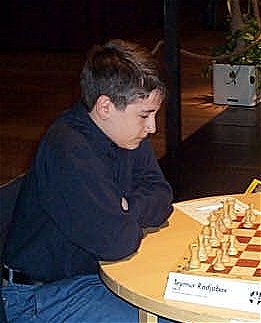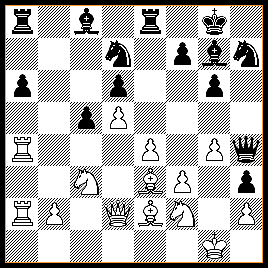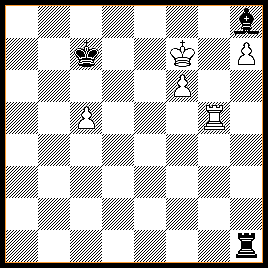International Master Profile: IM Teimour Radjabov

Today we would
like to introduce to you International Master
Teimour Radjabov. In the December 2000 First Saturday GM Tournament in Budapest
Hungary, this 13-year old boy convincingly won the tournament with a score a
full point above the GM-norm. Teimour is a very
serious and balanced person and we predict a very
bright future in chess for him. Soon he will play in the ĪBā tournament in
Wijk aan Zee and it will be very interesting to see
how he fares there.
Here is an interview conducted by GM Baburin on
the 15th of October 2000 on the Faeroes
Islands. This interview was originally published in Chess
Today.
Teimour, when and where were you born?
I was born on the 12th March 1987 in Baku.
When did you learn to play chess?
When I was 4.
Who is your coach now?
My father and computer.
Do you really think that at
this level a computer can help you?
No, but it is hard
to find a suitable coach, mistakes can be costly.
How do you work on chess?
Usually I study
chess for about 7 hours a day. I analyse my games
with computer, check chess periodicals, particularly
those openings, which I play.
How about books?
I just finished
reading book on the Candidate Tournament in Zurich
1953 by Bronstein — great book! I also
study game collections and recently looked at
Petrosian’s, Capablanca’s, Alekhine’s and
Botvinnik’s.
What about modern players? Who are your
favourites?
I like how Kasparov, Kramnik and Shirov play.
I like active play.
What programs do you use?
ChessBase and Chess Assistance.
What is your best result so far?
Probably winning the European Junior Championship under 18 in
1999, when I was 12.
Who are your main rivals, whom you’d like to
overtake?
I would like to overtake Bu, Ponomariov and
Grischuk.
Do you prefer to play with juniors or with
adults?
With adults. Among them there are many strong players, from whom I
can learn.
Who is the strongest player you have ever played?
GM Milov.
When you look at games of the so-called chess
elite, do you see a difference?
Yes, the difference between Kasparov, Kramnik, Anand or Morozevich
and somebody rated even 2640 is very considerable.
What attracts you in chess?
Atmosphere of the tournaments and desire to prove that I can play
better than my opponent.
Are you ambitious?
Yes.
You played here and could see that despite
so many GMs participating, we hardly had any
spectators. Many people believe that chess
needs shorter time control. What do you think about it?
I think that to
replace classical chess with just rapid chess
events would be a disaster. Rapid chess events
should exist alongside tournaments with classical time control.
Have you travelled much?
Yes, I have already been to 16 different countries.
What is your favourite country and city so far?
Switzerland and Biel.
Do you have hobbies?
I like reading, soccer and tennis.
Do you plan to become a professional player?
Yes.
What are your immediate plans?
I would like to become a Grandmaster and raise my rating.
Well, Teimour, good luck with your plans —
I hope that you will achieve them!
Play like Radjabov!
 |
 |
| White to move |
White to move |
The positions above occurred during games
played at the Budapest tournament mentioned at the top of the page. Take
your time, think about it, then refer to the answers below.
Radjabov,T (2476) - Barbero,G (2445) [A65]
FSGM December Budapest HUN (2), 04.12.2000
1.d4 Nf6 2.c4 c5 3.d5 d6 4.Nc3 g6 5.e4 Bg7 6.f3 0-0 7.Bg5 e6 8.Qd2 exd5 9.cxd5 a6 10.a4 Re8 11.Nge2 Nbd7 12.Ng3 Qa5 13.Be2 b5 14.0-0 bxa4 15.Rxa4 Qb6 16.Rfa1 h5 17.R1a2 Nh7 18.Be3 h4 19.Nh1 h3 20.g4 Qd8 21.Nf2 Qh4 22.Nb5 Nb6 23.Nc7 Nxa4 24.Nxe8 Bf8 25.Rxa4 Bd7 26.Bg5 Nxg5 27.Nf6+ Kh8 28.Nxd7 Bg7 29.f4 Nh7 30.g5 Bd4 31.Rxd4 cxd4 32.Qxd4+ Kg8 33.Ng4 1-0
Radjabov,T (2476) - Czebe,A (2520) [A40]
FSGM December Budapest HUN (4), 06.12.2000
1.d4 e6 2.c4 b6 3.a3 g6 4.Nc3 Bg7 5.e4 Ne7 6.Nf3 d6 7.Bd3 Nd7 8.Be3 Bb7 9.Qd2 h6 10.0-0 f5 11.Rae1 Nf6 12.exf5 Bxf3 13.gxf3 Nxf5 14.Kh1 0-0 15.Bxf5 exf5 16.Bxh6 Qd7 17.Rg1 Qf7 18.Qg5 Rae8 19.Rxe8 Rxe8 20.Qxg6 Qxg6 21.Rxg6 Re1+ 22.Kg2 Nh5 23.Bd2 Re8 24.Rg5 Nf6 25.Rxf5 c6 26.Bf4 Kf7 27.Bxd6 Kg6 28.Rf4 Bh6 29.Rh4 Bg5 30.Rh3 Bc1 31.Rg3+ Kf7 32.b4 Bxa3 33.Ne4 a5 34.bxa5 Nxe4 35.fxe4 Bxd6 36.Rf3+ Ke6 37.axb6 Rg8+ 38.Kf1 c5 39.e5 Be7 40.Rb3 cxd4 41.b7 Rb8 42.Rb5 Bg5 43.h4 Bf4 44.Ke2 Bxe5 45.h5 Bc7 46.Kd3 Kd6 47.h6 Rh8 48.Kxd4 Kc6 49.h7 Bb8 50.Rh5 Kxb7 51.Kd5 Kc7 52.Ke6 Ba7 53.f4 Bd4 54.f5 Rd8 55.c5 Bh8 56.f6 Rd1 57.Rg5 Re1+ 58.Kf7 Rh1 59.Rg7 Bxg7 60.Kxg7 Rg1+ 61.Kf7 Rh1 62.Kg6 Kd7 63.c6+ Ke6 64.c7 Rg1+ 65.Kh6 Rh1+ 66.Kg7 Rg1+ 67.Kf8 1-0
Answers to positions
above:
Left Diagram:
v. Babbero, G.
22. Nb5! |
Right Diagram:
v. Czebe, A.
59. Rg7! |
Problems and interview were originally published in Chess
Today.
|


